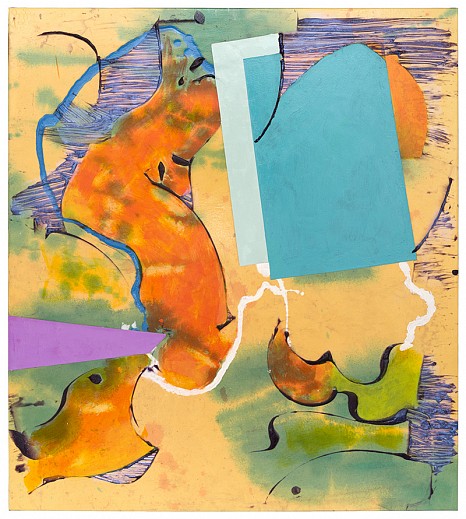
Walter Darby Bannard, 1934-2016
October 3, 2016 - Franklin Einspruch for Artblog.net
The presence of Walter Darby Bannard in my life was an accident. I went to graduate school at the University of Miami largely because my father was the dean of the College of Engineering and it made financial sense for my family. Darby was increasingly having trouble selling paintings in New York by the early '90s, he admitted to me, but he could have ended up at a lot of schools that would be happy to have someone of his caliber on the faculty. South Florida, he said, had the advantage of being warm.
That accident of life changed my whole course.
Grad school began with Hurricane Andrew blowing out one my studio windows, so I had to sweep up the coating of shredded leaves that the storm plastered over every exposed surface, outdoors or in. Just as momentous to me personally, during the previous summer I had seen a de Kooning at the New Orleans Museum of Art. I had never liked an abstract painting before, but I became interested in painting one. One of my classmates at UM was George Bethea, who had a longtime and profound interest in abstraction, was there to work with Darby, and was a year ahead of me. I basically copied George's studio setup. I stapled canvases to every available wall, gessoed them, and started painting.
Darby got wind of this and paid me a visit. That's your best one over there, he said.The one next to it is okay. Everything else is worse than both of them. It was all obvious to him. I was bewildered, but intrigued. I pulled the canvases down and stapled up fresh ones. We repeated that process regularly for two years.
For most of that time I knew nothing about Darby's trove of writings. He had them photocopied and stored away in his voluminous files, along with their manuscripts, aggressively banged out on an old manual typewriter. The first time I heard about Clement Greenberg, it was in a seminar led by Dr. Paula Harper, and I didn't have the slightest inkling that Darby and Clem had been friends since the '50s. Alan J. Smith, with whom I shared a studio, took it upon himself—Paula having assigned us a ten-page paper on a topic of our choice—to compile a 120-page analysis of Darby's writings. Such things were typical of the man.
I published my first art review, while still in grad school, for a now long-defunct weekly rag that was produced on Miami Beach. I gave it to Darby to comment upon, which he did: You can get an idea of what the art looks like from what you've written about it, which is extraordinary these days. My reaction was something like, what the hell is going on in art writing if that's so unusual?
It took a couple of years after school to figure out that there had been a massive backlash against Greenbergian modernism, and that certain figures associated with it, Darby included, were regularly denigrated by rote. Also, art writing had suffered a deluge of academic obscurantism, with which the demonization of Greenberg went hand-in-hand. Darby and I never got into any of that. We only talked about better art and worse art.
(It just hit me: I have mentioned five people in this post, and four of them are dead.)
Even then, it was only when I started publishing in earnest in the late '90s that I realized that I had subscribed to an ethos of plain looking, intuitive judgment, and clear writing about art that together are the essence of modernism, and that to exercise that ethos was to invite scorn. But to me, plain looking just felt like a sensible way to be an artist. Intuitive judgment, intelligently elucidated, just seemed like an honest way to be a critic. Darby had been acting accordingly for decades. I dug into his writings, andarchived them online. I began this blog, and Darby, identifying himself as Oldpro and then Opie, found great amusement in it, sharing his wisdom and arguing with his inimitable fortitude. Here on the blog you can watch his mind in action, the informal way in which he wielded his mighty intellect, running circles around his interlocutors. He was so damned smart, and he had such a jolly time being smart that he outshined every academic and every bien pensant that ever went up against him. At the same time, he knew the limits of smartness. Mere intelligence, he recognized, was not enough to apprehend or manifest art-value, what Greenberg used to call the quality of art quaart.
I'll let you in on a secret: the scorn never mattered. Darby lived well. His was a life full of brilliant friends, talented colleagues, and passionate relationships. Throughout it all and up to the end, he painted. When he was painting, canvases tacked to the floor, surrounded by jars of acrylics, and an arsenal of squeegees, brooms, and brushes at the ready, his enjoyment was unassailable. Art rides in on pleasure, he says in theAphorisms.
The pleasure carries something with it, something very precious to us that is inseparable from the pleasure itself.
I live with that something every day, but I can't say what it is. No one can. If you have an eye, you comprehend it in an instant; you feel it and you know it. That's that.
And now that really is that.
Back to News
